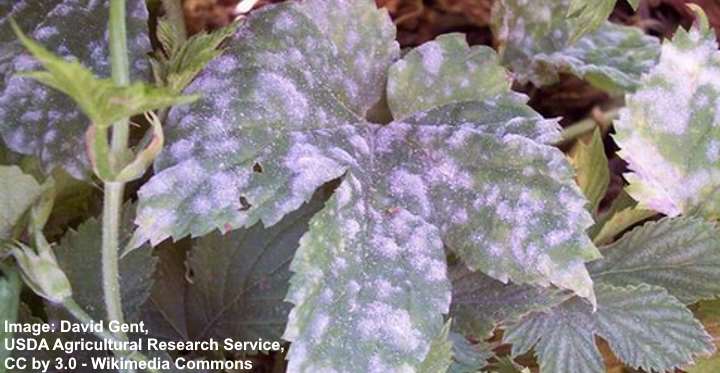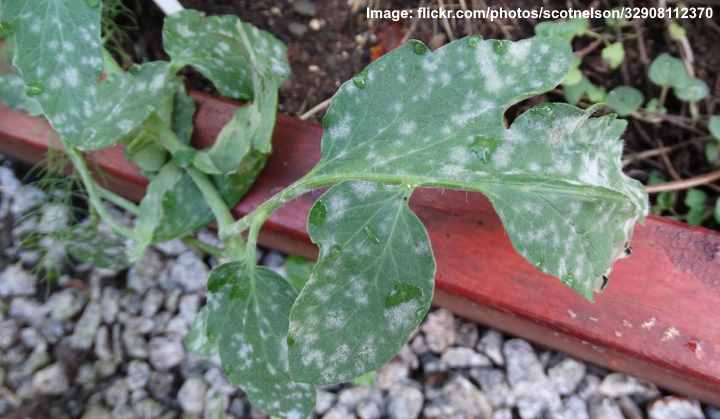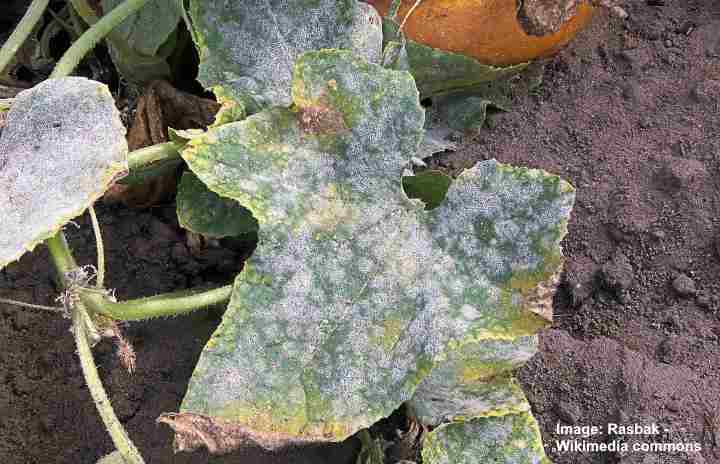Powdery Mildew on Plants: 4 Ways to Treat Powdery Mildew

Powdery mildew is a fungal plant disease that causes leaves and stems to look like they have a dusting of flour on them. Plant foliage with powdery mildew develops white, chalky-looking patches that make the leaves look diseased. In time, the leaves start to turn yellow and may drop off. Powdery mildew may not kill a plant, but the white, dust-like fungus makes plants look sick.
Like most fungal diseases, powdery mildew on plants occurs when temperatures are low, there’s little light, and the air is humid. One way to prevent powdery mildew is to avoid the conditions that cause the dusty gray-white coating on leaves.
Thankfully, there are easy ways to treat powdery mildew disease. Homemade powdery mildew sprays using milk, baking soda, or neem oil are excellent ways to get rid of powdery mildew naturally.
This article is a guide to the best treatments for powdery mildew. If your plant leaves look like they have a dusting of whitish powder, please continue reading to learn what to do.
What Is Powdery Mildew?

In the picture: white powdery mildew on tomato plant
Powdery mildew is a name for various fungal diseases that affect leaves and other parts of plants. The fungus spores appear on the surface of the plant’s foliage and look like dust or dirt. As the fungal infection spreads, the leaves and stems develop a superficial white powdery substance.
Depending on the extent of the infection, powdery mildew looks like a layer of gray dust. When there are only a few patches of dusty gray spores, it may be possible to wipe the leaf surfaces clean. However, blotches of whitish-gray fuzzy growth give the green foliage a dirty, grubby appearance.
According to researchers, there are around 900 fungi species that cause signs of powdery mildew. The most common is Erysiphe cichoracearum. However, all plant mildews result in the same symptoms—a grayish-white fuzz on plant leaf surfaces. Powdery mildew affects ornamental houseplants, greenhouse crops, and garden flowers.
What Causes Powdery Mildew on Plants?
Fungus spores that cause powdery mildew thrive when plants grow in low to moderate temperature and high humidity. However, dry conditions can also cause powdery mildew to spread further on plants. Most researchers agree that a lack of light, cool air, and humidity create the ideal environment for white fungus to grow on plants.
The United States Department of Agriculture (USDA) says that daytime temperatures around 80°F (26°C) and high nighttime humidity encourage fungal spore growth. The fuzzy white patches on leaves appear when the skies are overcast during warm, humid days, and the nights are cool.
Researchers from Penn State University say that powdery mildew can also develop on leaves when there is low daytime humidity, and temperatures are between 70°F and 80°F (21°C – 26°C).
Some studies show that powdery mildew develops on plants in humid conditions. In contrast, dry conditions can cause white plant fungus on other types of plants.
Other causes of powdery mildew can include the following:
- Poor air circulation around foliage traps in moisture and encourages fungal growth.
- Insufficient lighting affects plant growth, making them susceptible to disease. Also, fungal pathogens grow best in shaded conditions.
- Over-fertilization can make outbreaks of powdery mildew on plants common.
- Humidity can affect plant growth in different ways and cause white leaf fungus to appear. So, your houseplants and garden plants should grow in conditions with the appropriate humidity for their growth.
Is Powdery Mildew Dangerous?
Typically, powdery mildew doesn’t kill plants. However, the whitish-gray mold growing on plant foliage looks terrible. If powdery mildew continues to grow, the plant will lose nutrients, and its growth will slow and become stunted. The white plant mold will then cause leaves to turn yellow, become distorted, and damage buds and young fruit.
Because powdery mildew can cause damage to plants, you should try to eliminate the moldy substance as soon as possible.
Which Plants and Vegetables Are Most Susceptible to Powdery Mildew?

Powdery mildew on cucumber leaves
Powdery mildew can affect any plant growing outside in areas with humid summers. Unfortunately, the fuzzy white fungal mold can also affect houseplants such as begonias, ivy, jade plant, kalanchoe, and African violets. Temperatures around 70°F (21°C), low light, poor air circulation, and humidity conditions create the perfect environment for powdery mildew to affect indoor plants.
In gardens, powdery mildew can affect roses and other flowering plants. The white powdery growth on rose leaves occurs when there is high humidity, poor air circulation, lack of sunlight, and dry soil. Apart from causing a white power on leaves, powdery mildew can prevent rosebuds from opening.
Other crops susceptible to powdery mildew are cucumbers and other greenhouse vegetables. The warm, humid environment in a glass house allows fungus spores to thrive. If left untreated, powdery mildew on leaves can cause leaves to die and affect vegetable yield.
According to the University of California, plants and vegetables susceptible to powdery mildew include the following:
- Cucumbers
- Squash
- Potato
- Tomatoes
- Peas
- Carrots
- Beats
- Eggplant
- Broccoli
Other garden plants that powdery mildew affects are roses, zinnias, English ivy, lilac, begonias, snapdragons, and various ornamental and flowering trees.
Can Powdery Mildew Spread to Other Plants?
Powdery mildew can spread to nearby plants, especially in dry conditions. The winds can transfer fungus spores to other plants, where they will develop white spots on leaves. However, only certain types of fungi affect certain types of plants.
Suppose you spot signs of powdery mildew on houseplants or garden plants. In that case, it’s vital to treat the infection as soon as possible. It’s also crucial to improve your plants’ growing environment to prevent further outbreaks of powdery mildew on plants.
How to Treat Powdery Mildew

White mildew on the leaf of the English oak
The best way to treat powdery mildew is by spraying the leaves with solutions to eliminate fungus. Some of the simplest and most effective powdery mildew treatment methods are milk, baking soda, neem oil, and diluted vinegar. These natural ingredients have natural anti-fungal properties and won’t damage plant foliage or pose a risk to your family’s health.
Another compelling reason to look for natural treatments for powdery mildew is fungicide resistance. The journal Microorganisms reported that many fungal strains that cause powdery mildew are resistant to commercial fungicides. This means that many chemical methods of eliminating powdery mildew are no longer useful.
Powdery Mildew Spray
You can make homemade sprays to treat plants with powdery mildew. The good news is that you probably have the ingredients you need to make a powdery mildew spray in your pantry. All you need to make your spray is a spray bottle, water, and ingredients such as baking soda or milk.
Scientific research on effective powdery mildew treatments found that natural ingredients are highly effective. For example, scientists found that sodium bicarbonate (baking soda) and milk suppressed and reduced the severity of powdery mildew outbreaks. Other treatments included garlic and acetic acid (vinegar).
When using foliar sprays for powdery mildew, there are a few things to keep in mind:
- Always test a small area of the plant first to see if there is a reaction.
- The best time to apply powdery mildew sprays is in the morning.
- Only apply once a week for the best results.
Milk Spray for Treating Powdery Mildew
Making a spray with milk to apply to affected leaves can help treat powdery mildew on plants. Milk has anti-fungal properties and will help improve your plant’s health. Also, milk is non-toxic and a mild fungicide, so it’s rare that milk would damage plant foliage.
To make a milk spray for powdery mildew, mix 6 fl. oz. (180 ml) of milk with 14 fl. oz. (400 ml) of water. Pour the milk solution into a spray bottle. Spray liberally on all plant leaves, making sure you also coat the leaves’ underside to help eradicate all traces of powdery mildew. Allow to dry. Repeat weekly until signs of powdery mildew have gone.
With the homemade powdery mildew milk spray, you can use skimmed or whole milk.
There is scientific evidence for using milk to treat powdery mildew. The journal Crop Protection reported that milk-based plant sprays could treat and prevent fungal infections. Compared to chemical sprays, whole milk was up to 70 percent as effective.
Baking Soda Spray to Get Rid of Powdery Mildew
A baking soda solution is another effective homemade spray for powdery mildew. Baking soda (sodium bicarbonate) also has useful anti-fungal properties that can neutralize mold on plants. Applying a baking soda spray can help prevent the spread of powdery mildew to other plants.
To make a baking soda foliar spray for powdery mildew, combine 1 tablespoon of baking soda and 1 gallon (3.8 l) of water and mix well. Pour the mixture into a spray bottle and add 1 teaspoon of liquid Castile soap or dish soap. Mix well to combine the ingredients. Spray the baking soda on plants affected by mold to eliminate powdery mildew. Always ensure you liberally coat both sides of the leaves and allow them to dry.
Neem Oil Spray to Get Rid of Powdery Mildew
Spray plant leaves with neem oil to eradicate white mold from foliage and stems. Neem oil has natural anti-fungal properties and also acts as a natural pesticide. A simple combination of organic neem oil, Castile soap, and water can be enough to eliminate powdery mildew and keep your plants free from pests.
Make a neem oil spray by combining 2 teaspoons neem oil, 1 teaspoon liquid dish soap or Castile soap, and 1 quart (1 l) of water. Put all the ingredients in a spray bottle and shake vigorously. Copiously spray the neem oil treatment on all leaves showing signs of powdery mildew to get rid of the fungal disease. Leave to dry and repeat weekly if necessary.
Scientific research has shown neem oil to be useful as a plant-based fungicide. One study reported that all parts of the neem plant have anti-fungal properties. A simple neem oil solution sprayed on lilac bushes and hydrangeas was sufficient to prevent outbreaks of powdery mildew.
Related reading: How to use neem oil on plants.
Vinegar Spray to Treat Powdery Mildew
The acetic acid in vinegar also has anti-fungal properties that can be effective for treating powdery mildew. Because vinegar can burn foliage, you should use this method with caution. Before spraying diluted vinegar on leaves that have white mold, it’s best to test the solution on a small area of the plant.
Make a vinegar spray for powdery mildew by mixing 2 tablespoons of white vinegar with 1 gallon (3.8 l) of water. Pour the solution into a spray bottle and apply to the plant. As with all powdery mildew sprays, coat the leaves’ upper side and underside to eradicate white mold.
How To Prevent Powdery Mildew
The best way to deal with plant fungus such as powdery mildew is to prevent it in the first place. Because growing conditions often cause outbreaks of white mold on plants, it’s vital to provide the optimal environment for healthy plant growth. This means getting factors such as moisture, heat, and light right.
Here are some helpful tips on preventing powdery mildew on houseplants and garden plants and vegetables.
Prevent powdery mildew by managing humidity
Too much air moisture or a lack of humidity can result in powdery mildew. It’s crucial that plant foliage has enough room to grow, and there is plenty of space for air to circulate. Ensure that plants don’t grow too close together. Also, prune shrubs to help increase air circulation and lower humidity levels.
Soil management helps prevent powdery mildew on plants
Avoid letting plants—garden plants or houseplants—sit in waterlogged soil. Most plants require growing in soil that has excellent drainage yet holds some moisture. It would generally be best to water plants when the top layer of soil or ground has dried out.
Watering when the ground is partially dry also helps to prevent white mold on soil.
During hot, dry periods, you will have to water plants more frequently. This advice also helps prevent powdery mildew as it avoids stressing plants due to a lack of water.
Another soil management tip to prevent powdery mildew is to go easy on fertilization. Each plant has its own nutrient requirements. However, too much nitrogen in the ground can make plants susceptible to powdery mildew.
Grow plants in the right location to avoid powdery mildew
Make sure plants get adequate sunlight to prevent outbreaks of white mold on leaves. Most plants prefer growing in full sun to partial shade, and sunlight prevents fungus spores from multiplying.
In shaded areas of your garden, plant shade-loving plants that are not prone to powdery mildew. For example, garden plants such as hostas, liriope, and creeping buttercup are ideal plants for shade. Indoors, sansevierias, golden pothos, prayer plants, and ZZ plants grow well in darker rooms with little sunlight.
Water plants correctly to prevent powdery mildew
Because fungus tends to grow in dark, damp places, it’s vital to water plants correctly.
First, avoid watering garden plants early in the morning or late in the evening. The lack of sunlight and cool air can create perfect conditions for powdery mildew to thrive.
Second, when watering plants indoors and in your yard, avoid water splashing on leaves. However, it is usually best to water garden plant foliage in warm, dry weather in mid-morning. This watering method can prevent exceedingly dry conditions from causing powdery mildew on leaves of some plants.
Related articles:
